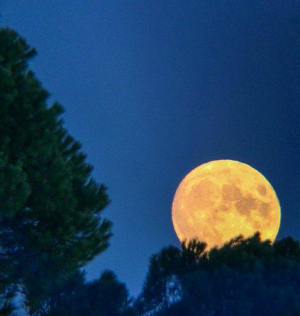|
Tonight's full moon mimics path of July sun |
|
January 11, 2017 |
By Bruce McClure
EarthSky.org
 |
| A January
rising full moon in Italy, in 2015, via
Osservatorio Astronomico Università di
Siena. |
Tonight – January 11, 2017 – the moon will
appear bright and full in the sky from around
the world. It’ll look full tomorrow night, too,
because, in fact, the moon appears full for a
couple of nights around its fullest phase.
That exact fullest moon falls on January 12 at
11:34 UTC. For the mainland United States, the
moon reaches the crest of its full phase before
sunrise January 12, 3:34 a.m. PST.
Thus if you’re in the Americas, your fullest
moon falls during the night of January 11, or,
more precisely, in the hours before dawn January
12. If you’re in Asia, the moon is fullest for
you on the night of January 12. If you’re in
between, pick one or both for moon-watching.
Either night will do!
The January 2017 full moon counts as the first
full moon after the December solstice. In North
America, we often this full moon the Wolf Moon,
Old Moon or Moon After Yule.
Astronomically speaking, the moon is full at the
moment that it’s most opposite the sun in its
orbit (180o from the sun in celestial or
ecliptic longitude). That’s what the time of the
full moon means. But of course the moon at the
vicinity of full moon shines all night long,
from dusk to dawn, as seen from around the
globe.
n both the Northern and Southern Hemispheres,
the January sun – unlike the January full moon –
rises south of due east and sets south of due
west. In the Northern Hemisphere, these
far-southern risings and settings of the sun
give us the short days of winter.
South of the equator, the same far-southern
sunrises and sunsets bring long summer days.
Meanwhile, the full moon lies opposite the sun,
mirroring the sun’s place in front of the
backdrop stars for six months hence.
And that’s why tonight’s moon – like the sun in
summer – will follow a high path across the sky
as seen from the northern part of the globe –
and a low path as seen from the southern.
This January full moon rises north of due east
around sunset, climbs highest in the sky around
midnight and sets north of due west around
sunrise. |
|
Questions or comments about this
article?
Click here to e-mail! |
|
|
|
|

